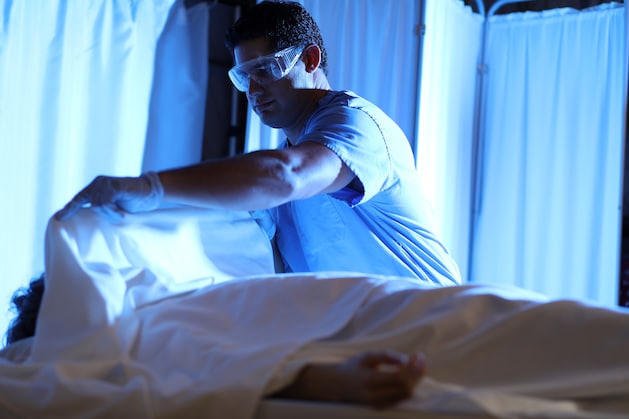Preserving the dead in the icy cold and simply thawing them again later – cryonicists hope for a second life. It is unclear whether this will ever work. But why do they still believe in it?
When Klaus Sames’ life comes to an end, one thing is certain for him: “I don’t want to become a corpse,” says the 85-year-old. Cryonics is intended to prevent this: Sames’ blood is replaced with a medical antifreeze and his body is cooled with liquid nitrogen at -196 degrees Celsius. This process is called cryopreservation. In the distant future, Sames wants to thaw out again – when deadly diseases could be curable and aging could be reversed. But critics don’t believe this will ever succeed.
Sames is considered one of the cryonics pioneers in Germany. He is actually a gerontologist and after his retirement he researched and lived near Ulm for a long time. He has since moved to Hersbruck in northern Bavaria. He says that he used to want to use his research to help eliminate aging. But he didn’t succeed. That’s why he now relies on cryonics – also called biostasis – and sees it as a consistent continuation of his work. “Medicine is life support, and we are simply expanding the possibilities.”
Cryopreservation has long been used for sperm, eggs and embryos. Stefan Schlatt, Professor of Reproductive Medicine at the University of Münster, believes that this also works with organs and entire bodies is unrealistic because their complexity is too high. “We’re getting better at freezing, but there won’t be a magic bullet.”
He certainly doesn’t think it’s desirable: “That’s a wrong attitude to life.” Every living being has an internal clock that starts ticking when they reach sexual maturity. “It is extremely important for evolution that living things die and make room for the next generation.”
Eternal life – that’s what people have dreamed of since time immemorial. Numerous science fiction novels and films revolve around people spending decades or centuries in cold sleep and then being awakened again. When cryopreservation emerged in the 1960s, it was itself a kind of science fiction, says Sames. “Now we’ve come a long way.” Nevertheless, “It’s not working yet,” he admits.
So what drives people like him? “Cryonics basically promises the fountain of youth,” says doctor Eckhard Nagel from the University of Bayreuth. “This is practically a compensation for the fear of dying and is an expression of the inability to come to terms with one’s own finiteness.” However, the idea is absurd, says Nagel. “Even if you could treat the cause of a person’s death in the future and actually succeed in getting a function out of a body flooded with antifreeze, you would usually only awaken a dead body at the end of its natural existence to a life without prospects.”
Sames still sees no alternative: “Death or cryonics,” he says. He’s willing to pay a lot for the chance to get a new life in the distant future. He paid $28,000 to the Cryonics Institute in the US to have his body kept hanging upside down in a cooling tank.
According to the institute, 250 people are already being stored in this way, and almost 2,000 more have contracts like Sames. The other major US provider Alcor comes up with similar figures, but takes $200,000. Both were founded in the 1970s and describe themselves as non-profit organizations.
You could dismiss the whole thing as a strange idea from older people who are afraid of death at the end of their lives. But many young people are also concerned with the questions: what comes next and does life really have to end at some point? Two years ago, the doctor Emil Kendziorra founded the start-up Tomorrow Bio in Berlin, which offers cryopreservation in Europe. According to him, 400 to 500 people now have a contract, including himself. The majority of them are between 30 and 50 years old, says the 38-year-old.
The company has converted several ambulances into mobile treatment rooms. Ideally, the team would be on site shortly before someone dies, says Kendziorra. As soon as the customer is declared clinically dead, cryopreservation can begin. They would be stored in a facility in Switzerland. The whole thing costs 200,000 euros – with the majority of 120,000 euros going to a foundation that invests the money to finance the storage of the bodies for an indefinite period of time, explains Kendziorra.
This reminds the Bayreuth doctor Nagel of the sale of indulgences in the Middle Ages. He took advantage of people’s lack of information and basic fear of eternal burning in hell in order to ask them to pay. “That’s exactly what cryonics does today. This obviously hasn’t lost any of its relevance, nor has it lost any of its reprehensibility.”
Reproductive medicine specialist Schlatt also finds this questionable from an ethical perspective: “This is an incredibly disgusting business dealing with the hope of something that will never exist.”
Kendziorra rejects this. “I could earn money better somewhere else.” The company’s goal is to make cryopreservation cheaper – and it will be if more people decide to do it. However, he confirms that the whole thing is fraught with uncertainty: “You are betting to some extent on future technologies.” He also sees many open questions and problems. He explains this to all customers. “I don’t want anyone to choose cryopreservation who isn’t aware of it.”
Sames and Kenzdiorra are hopeful for progress in nanotechnology. Nevertheless, a lot of research is still needed, says Sames. A major obstacle is warming the body after cold sleep without causing any damage. Promising methods are being developed.
One main problem remains: methods to reverse aging and the associated pathological changes. It will certainly take 200 years before medicine is ready, says Sames. “We’ll have to wait and see.”















